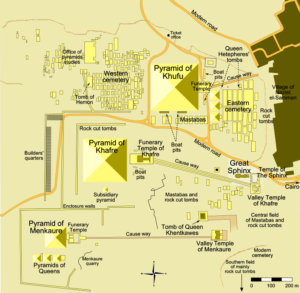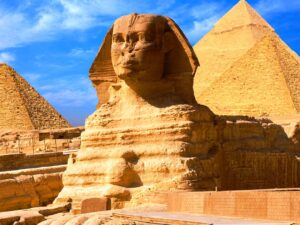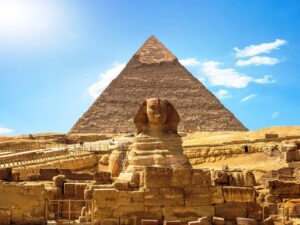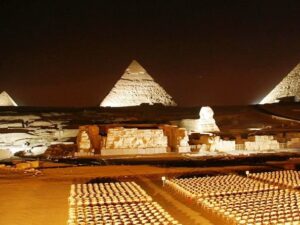» posted on Friday, August 12th, 2022 by Linda Lou Burton
Time Will Tell
 Originally published August 8, 2020 by Linda Lou Burton posting about Cairo, Egypt from Little Rock, Arkansas – Giza is an Egyptian city on the west bank of the Nile, near Cairo. The Giza Plateau is home to iconic Egyptian monuments, including three tall pyramids built as royal mausoleums around the 26th century BC. The largest, the Great Pyramid, is King Khufu’s tomb. The Great Sphinx is a vast sculpture of a lion’s body with a human head. The site is at the edges of the Western Desert, approximately five miles west of the Nile River in the city of Giza, and about eight miles southwest of the city center of Cairo.
Originally published August 8, 2020 by Linda Lou Burton posting about Cairo, Egypt from Little Rock, Arkansas – Giza is an Egyptian city on the west bank of the Nile, near Cairo. The Giza Plateau is home to iconic Egyptian monuments, including three tall pyramids built as royal mausoleums around the 26th century BC. The largest, the Great Pyramid, is King Khufu’s tomb. The Great Sphinx is a vast sculpture of a lion’s body with a human head. The site is at the edges of the Western Desert, approximately five miles west of the Nile River in the city of Giza, and about eight miles southwest of the city center of Cairo.
 The Great Pyramid (Khufu) and the Pyramid of Khafre are the largest pyramids built in ancient Egypt, and they have historically been common as emblems of ancient Egypt in the Western imagination. The Great Sphinx of Giza is a limestone statue of a reclining sphinx, a mythical creature with the body of a lion and the head of a human. Facing directly from West to East, it is generally believed to represent the pharaoh Khafre.
The Great Pyramid (Khufu) and the Pyramid of Khafre are the largest pyramids built in ancient Egypt, and they have historically been common as emblems of ancient Egypt in the Western imagination. The Great Sphinx of Giza is a limestone statue of a reclining sphinx, a mythical creature with the body of a lion and the head of a human. Facing directly from West to East, it is generally believed to represent the pharaoh Khafre.
Freeze Frame
Hold on, hold on. There are encyclopedias, yea, libraries and museums, filled with theories and suppositions about what it all is, and what it means. Why were these structures built? Exactly when? And more to the question, exactly how? Their size, and endurance, defy explanation, based on what we know today about construction techniques, which we (foolishly?) believe have evolved over time. Today I’m not out to prove anything, or solve a mystery. I just want to SEE these awesome creations, especially the mysterious Sphinx, for myself. Writers and scholars over time have recorded their impressions and reactions upon seeing the Sphinx. A general description, often a mixture of science and mystique, is typical of what I have found; I particularly like this rather flowery one by John Lawson Stoddard, a writer who began traveling the world in 1874 and publishing books about his experiences:
 It is the antiquity of the Sphinx which thrills us as we look upon it, for in itself it has no charms. The desert’s waves have risen to its breast, as if to wrap the monster in a winding-sheet of gold. The face and head have been mutilated by Moslem fanatics. The mouth, the beauty of whose lips was once admired, is now expressionless. Yet grand in its loneliness, – veiled in the mystery of unnamed ages, – the relic of Egyptian antiquity stands solemn and silent in the presence of the awful desert – symbol of eternity. Here it disputes with Time the empire of the past; forever gazing on and on into a future which will still be distant when we, like all who have preceded us and looked upon its face, have lived our little lives and disappeared.
It is the antiquity of the Sphinx which thrills us as we look upon it, for in itself it has no charms. The desert’s waves have risen to its breast, as if to wrap the monster in a winding-sheet of gold. The face and head have been mutilated by Moslem fanatics. The mouth, the beauty of whose lips was once admired, is now expressionless. Yet grand in its loneliness, – veiled in the mystery of unnamed ages, – the relic of Egyptian antiquity stands solemn and silent in the presence of the awful desert – symbol of eternity. Here it disputes with Time the empire of the past; forever gazing on and on into a future which will still be distant when we, like all who have preceded us and looked upon its face, have lived our little lives and disappeared.
Forced to Be A Tourist
 Even though the Sphinx is sitting there waiting for me, just eight miles from my hotel room, I am not renting a car and driving myself for the kind of leisurely visit I’d like to make. So I’ll play like a tourist, and wangle two back to back tours that maybe will allow me to feel as moved, on reflection, as Stoddard was.
Even though the Sphinx is sitting there waiting for me, just eight miles from my hotel room, I am not renting a car and driving myself for the kind of leisurely visit I’d like to make. So I’ll play like a tourist, and wangle two back to back tours that maybe will allow me to feel as moved, on reflection, as Stoddard was.
First the “half-day private tour with 30-minute camel ride” for the afternoon: Gain from the expertise and personalized attention of an Egyptologist as your guide to the Giza Plateau. Enjoy photo ops of the Great Sphinx and the Great Pyramid at Giza, one of the Seven Wonders of the Ancient World. Lunch and hotel transport by minivan are included. Entrance fees included.
 And then, for the evening, a “multimedia sound and light show”: See the world’s only surviving ancient wonder light up at night during this multimedia show. Sit in front of the Great Pyramids of Giza and listen to the history of ancient Egypt with image projections on the monument. Take photos of the projections during this 1-hour sound and light show and learn about ancient Egypt’s history spanning more than 5,000 years as you sit back and enjoy complimentary snacks. Round-trip transportation from your Cairo hotel.
And then, for the evening, a “multimedia sound and light show”: See the world’s only surviving ancient wonder light up at night during this multimedia show. Sit in front of the Great Pyramids of Giza and listen to the history of ancient Egypt with image projections on the monument. Take photos of the projections during this 1-hour sound and light show and learn about ancient Egypt’s history spanning more than 5,000 years as you sit back and enjoy complimentary snacks. Round-trip transportation from your Cairo hotel.
Will I remember the Cheetos, or the grandeur? Time will tell.
